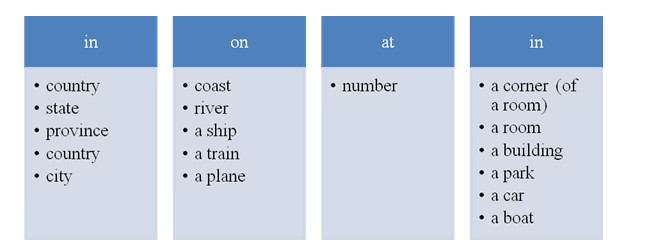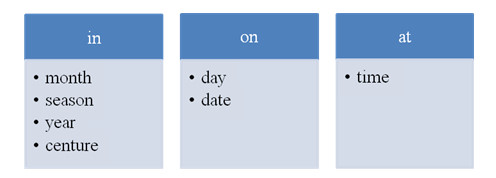Свець М.А. Specific features of prepositions in the English language
Матеріал з PSYH.KIEV.UA -- Вісник психології і соціальної педагогіки
Свець Маріанна Анатоліївна – студентка Педагогічного інституту Київського університету імені Бориса Грінченка, напрям підготовки «Початкова освіта», кафедра іноземних мов і методик їх навчання Київського університету імені Бориса Грінченка
У статті розглядається поняття «прийменник», а також специфіка його вживання та використання англійською мовою. Обґрунтовано важливість вдосконалення навичок говоріння для здійснення успішного спілкування за допомогою прийменників. Автор подає основні типові помилки при вживанні прийменників, демонструє способи, які допоможуть краще їх зрозуміти.
Ключові слова: прийменник, використання прийменників, типологія прийменників, прийменники місця, часу та способу дії.
В статье рассматривается понятие «предлог», а также особенности его употребление в английском языке. Обосновано важность совершенствования навыков говорения для осуществления успешного общения с помощью предлогов. Автор предоставляет основные типичные ошибки при использовании предлогов, демонстрирует способы, помогающие лучше их понять.
Ключевые слова: предлог, использование предлогов, типология предлогов, ошибки, предлоги места, движения, времени и образа действия.
This article examines the notion of ‘preposition’, specific features of prepositions in the English language. The importance of improving speaking skills for the successful communication is substantiated using preposition. The author highlights main mistakes and common errors in their using, shows methods that can help in understanding of these terms.
Key words: preposition, using prepositions, kinds of prepositions, prepositions place and movement, time and manner.
Зміст |
Problem setting
It’s very difficult to use prepositions correctly in English. Therefore, they present a number of problems for both teachers and learners.
However, if we analyze patterns of occurrence of using prepositions we can identify key concepts in meaning and usage which consistently apply and can be used as a platform for learning.
So, specific features of prepositions in the English language were chosen as an issue of our article.
The analysis of research
The study of prepositions has been one of the most important issues in linguistics for the long period of time. Many analyses have been proposed to show how one usage can be construed as an extension of another.Such scientists as Castro, M., Evans, V., Kimber G., Koffi, E., Lindstromberg, S., Tyler A., Zbarinezan F., Zubaida T., Najimhave devoted their works to the problem of learning prepositions.The journalist Adam J. Simpson examines prepositions, too.
The aim of the article
Learning prepositions is a topical problem, because it regularly stimulates learners to avoid mistakes in using correct preposition. That’s why, our article is devoted to the problem of the specific features of prepositions in the English language.
The aim of our research is to analyse theoretical issues and to summarize the specific features of using prepositions and ways of eliminating mistakes in the English language. Thus, the tasks of our investigation are: to examine the notion of preposition; to describe specific features and functions of prepositions.
The main material
A preposition is a word that indicates location (in, near, beside) or some other relationship (about, after, besides) between a noun or pronoun and other parts of the sentence. Koffi, E. says that English has 60 to 70 prepositions; a higher number than most other languages [3, p. 297].
First of all, most prepositions, especially the common ones, have several different functions. For example, the preposition ‘at’, has near 18 different functions, depending on which dictionary you consult. As vocabulary items in their own right, prepositions can, therefore, be a major challenge and it's usual for learners of English ask teachers to explain what words such as ‘at’ means [5].
Secondly, why do we say ‘The bank is in Wisteria Lane’ and ‘They live at 132, Wisteria Lane’?
A preposition expresses a relationship of meaning between two parts of a sentence, most often showing how the two parts are related in place or time: We sat on the bench. They left at three [2].Most of the common prepositions consist of only one word; they have no distinctive ending, and do not vary. Several prepositions consist of more than one word.
Most of the prepositions in English are simple one-word prepositions – about, at, before, by, down, for, from, in of, on, out, over, round, since, to, under, up, with. Some are multi-word prepositions (also called two-word, three-word, or compound prepositions) – (two-words) ahead of, because of, due to, instead of, near to; (three words) as far as, by means of, in accordance with, in spite of, on behalf of.
So, in the English language we have approximately 70 simple prepositions. About half of them have two syllables (under, over, behind, without) or more (underneath, notwithstanding).
Many of these words show location (on, off, behind, under, etc.), some show time (before, after), while others show less concrete relationships (of, for, to, with).
Commonly used prepositions are:
| above | about | across | after |
| behind | below | beneath | beside |
| for | from | in | inside |
| since | to | toward | through |
| against | along | among | around |
| between | beyond | by | down |
| into | until | near | of |
| under | up | at | on |
These are the 9 most frequently used prepositions: at, in, on, by, for, from, of, to, with.
However, this grouping is somewhat misleading, because each form has multiple meanings and functions.
Prepositions are important when constructing sentences. A preposition sits before a noun to show the noun's relationship to another word in the sentence. Examples:
It is a container for butter (the preposition for shows the relationship between butter and container).The eagle soared above the clouds (the preposition above shows the relationship between clouds and soared).
Following are the other types of prepositions.
• Prepositions of Place. Those prepositions which are used to show that place where something is located, to describe the place or position of nouns. We have basically three prepositions of places.
Notice, that in, on, at have similar meanings, but they are used with different kinds of places. In general, in is used before large places; on is used before middle-sized places; and at is used before numbers in addresses. Finally, in is used again before very small places.
E.g. We live in the United States in North Carolina in Jacksonville on the East Coast on New River at 2600 River Road.
Other examples of prepositions of place are: between and among have the same meaning, but between is used with two nouns and among is used with three or more nouns or a plural noun.
E.g. The house is between 3rd Street and 4th Street. The rent payments are divided among Mike, Bill, and Steve.
• Prepositions of Time (since, for, by, from, to, from, until, at, on, in, during) used to show when something happens.
Notice, that in, on, and at have similar meanings, but they are used with different times. In general, in is used before large units of time; on is used before middle-sized units of time; and at is used before numbers in clock time.
Idiomatic phrases such as in the morning, in the afternoon, in the evening, at night, at noon must be learned individually like vocabulary.
E.g. Mary was born in 1985 in June on Monday at 8 o’clock.
• Preposition of Movement (to, towards, into, onto through, across, over) is used to show direction of movement.
E.g. He went to the park (signifies movement toward a specific destination). The helicopter flew towards south (suggests movement in a general direction). Clara jumped onto the bench.
• Prepositions of Manner tell how something is done.
E.g. I went with my husband (used for accompaniment). I made a blog for writing (used for “purpose” or reasoning). I want a piece of the pie (used for association or measure). I get paid by the hour (used to show measurement). She looks like Britney Spears (used to show similarity). I work as a tutor (used to show capacity).
But sometimes there are many mistakes in using prepositions [1].
Non-native speakers of English tend to have three types of problems with prepositions:
1. Using the wrong preposition, e.g.: My grandfather picked the name on me. (for)
2. Omitting a required preposition, e.g.: I served the Army until 1964. (in)
3. Overusing preposition, e.g.: I studied in Biology for three years.
Many errors occur with the prepositions in, on, and at. These prepositions, all associated with temporal and spatial relationships, are easily confused.
1. Spatial meanings of in', on, at:
John is standing on the sidewalk (two-dimensional).
John is at the corner (one-dimensional: point/intersection).
John is in the house (three-dimensional).
John is at the door/window (in the general area).
2. Temporal meanings of in, on, at:
It happened in 1960. (for months, seasons, years, and periods of the day–including the morning, evening, afternoon)
It happened on Dec. 10. (for dates and days of the week)
It happened at 9:15. (for times of the day–includes noon, midnight, night, dawn,dusk, sunrise, and sunset.)
3. Source meanings of from and (out) of:
Paper is made from wood. (source not visibly obvious)
This table is made (out) of wood. (source not visibly obvious)
4. Temporal use of in/within (not the contrast):
Come back in 30 minutes. (30 minutes from now)
Come back within 30 minutes. (refers to duration of span)
5. Since/for to express spans of time:
I have lived here since 1960. (refers to beginning of span)
I have lived here for 16 years. (refers to duration of span)
There are potential difficulties with prepositions of place. We say we are at the hospital to visit a friend who is in the hospital. We lie in bed but on the couch. We watch a film at the theater but on television. For native speakers, these little words are not difficult, but try to learn any other language, and you will quickly discover that prepositions are troublesome wherever you live and learn. Here are some interesting (sometimes troublesome) prepositions. To address all the potential difficulties with prepositions in idiomatic usage would require volumes, and the only way English language learners can begin to master the intricacies of preposition usage is through practice and paying close attention to speech and the written word. Keeping a good dictionary close at hand is an important first step to be good at this issue.
Our advice how to avoid mistakes related with prepositions follow next rules:learn by heart the prepositions in phrases like set expressions(in the morning, but at night).
Conclusion
During our scientific research we have provided an explanation of the preposition, described specific features and functions of prepositions and characterized the main problems of prepositions.
Most English prepositions have several different functions and at the same time different prepositions can have very similar uses. Many nouns, verbs, and adjectives are normally used with particular prepositions. Often, the correct preposition cannot be guessed. One has to learn the expression as a whole. That’s why, sometimes it is very difficult to use a proper prepositions in English sentences for most learners
Список використаних джерел
- Jiménez, R. M. Frequency and variability in errors in the use of English prepositions. / Jiménez, R. M. // A Journal of English and American Studies. – 1996. – №17. – P. 171-187.
- Kimber,G. Perfect Prepositions: A Real Life Guide to Using English Prepositions / G.Kimber. – New York: iUniverse, 2006. – 244 p.
- Koffi, E. Applied English syntax: Foundations for word, phrase, and sentence analysis. / Koffi, E. – Dubuque, Iowa: Kendall Hunt Publishing Company, 2010. – P. 297.
- Lindstromberg, S. Prepositions: Meaning and method / Lindstromberg, S. // ELT Journal. – 1996. – №50. – p. 225-236.
- Simpson, A. How to help learners of English understand prepositions [Електроннийресурс] / Adam J. Simpson // British Council. – 2014. – Режимдоступудоресурсу:http://www.britishcouncil.org/blog/how-help-learners-english-understand-prepositions.
- Tyler, A. The Semantics of English Prepositions: Spatial Scenes, Embodied Meaning and Cognition. / Tyler, A., Evans, V. – Cambridge: Cambridge University Press, 2003.

